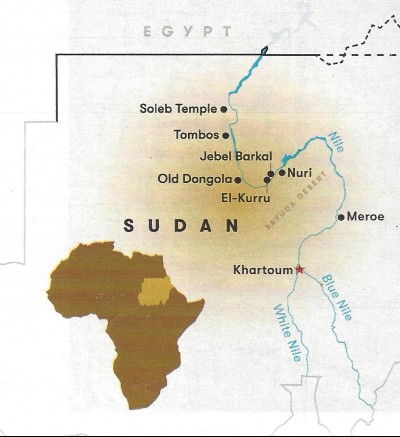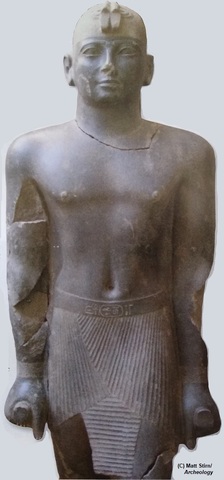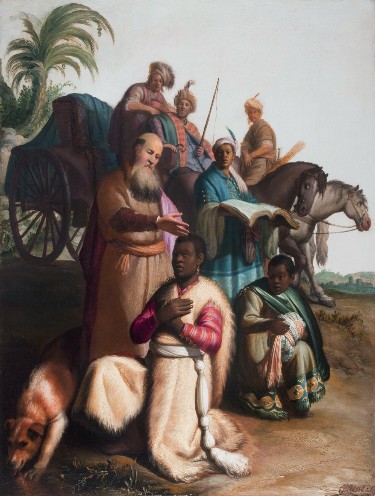When Africa Helped Israel: The Nubian Connection!
By Neil Earle

South of Egypt and north of Ethiopia in the country we now know as Sudan in northeast Africa lived a group of people known as Nubians or Kushites (Cushites).
With Sudan now shrugging off its deadly political battles, archaeologists are fascinated by the strength and wealth of this ancient people that dominated the Upper Nile and at times controlled Egypt itself. Khartoum, at the division of the White Nile and Blue Nile, is probably the most famous city to Westerners but researchers are now poring over places such as Meroe and Kerma for in-depth evidence of this powerful empire that prospered from 2500 BC down to about 300 AD.
“The kingdom rivaled and at times overtook Egypt,” writes Ismail Kushkush in the September 2020 issue of Smithsonian magazine. “This first Kushite kingdom traded in ivory, gold, bronze, ebony and slaves with neighboring states such as Egypt and ancient Punt, along the Red Sea to the east, and it became famous for its blue glazed pottery and finely polished, tulip-shaped red-brown ceramics.”
Even more relevant for students of Bible history and prophecy are the connections Kushite-Nubians had with the ancient Israelites and the early New Testament church. It makes an interesting tale.
“An ancient people and a strong”
Cush or Kush is listed as one of the grandsons of Noah in the Table of Nations chart in Genesis 10. He engendered Nimrod the “mighty hunter before the Lord” (Genesis 10:1-9). One of the names for the Cushite part of Africa was Ta-Seti or Land of the Bow, a tribute to their skill as archers and, as we shall see, to their military prowess. The Greeks called this region “Ethiopia” or “Land of Burnt Faces,” a title that endures in East Africa. The descriptor “Nubia” itself may be derived from an ancient Egyptian word for gold, which was plentiful and something for which most of Africa has been and still is famous.
The authoritative Hallo and Simpson text The Ancient Near East attests to the wealth flowing from the Nubian-Kushite regions as depicted on the Egyptian monuments: “Among the colorful elements of the procession are giraffes, monkeys, elephant tusks, varied hides and leather goods, ostrich feather fans, semi-precious stones, and of course ingots of gold and bags of gold dust. Egyptian temples were erected in Nubia and the Sudan” (page 261). These rich exotic regions played a key role in ancient history and did not escape notice.
These sub-Saharan people were distinct from the more copper-skinned Egyptians we see depicted on the pyramids and tombs. “The Egyptians, who knew the Cushites best, consistently depicted them with black skin pigmentation,” says Kevin Burrell in Biblical Archaeology Review (Winter 2020). “The Assyrian king Esarhaddon…stated that (the Nubian king) and the members of his royal family were ‘dark as pitch’….” Burrell adds that for Greek historian Herodotus the Ethiopians are “black ‘by reason of the sun’ and he twice refers to the southerners as ‘the tallest and most handsome of all men’” (Histories 3.20).
The point is this was clearly an African kingdom with a history of accomplishments not all Western scholars have been eager to credit. Secular descriptions are quite in line with what the Hebrew prophet Isaiah recorded about the Ethiopians, the word Isaiah used for the whole Cushite region. Isaiah 18:2 refers to a nation “tall and smooth.” That chapter begins to unlock the fascinating interactions between Israel and the Kushite Empire, a people mentioned some 54 times in the Bible. And for a reason.
Israel’s Unlikely Allies
 Pharoah Taharka (c. 701-669) – Judah’s Ally
Pharoah Taharka (c. 701-669) – Judah’s AllyIn 2002 the non-specialist historian Henry T Aubin published The Rescue of Jerusalem. Aubin reiterated the well-known historical fact that the Nubian king Taharka in 701 BC made a strategic attack on the Assyrian King Sennacherib’s forces that were besieging the Jewish king Hezekiah in his fortress of Jerusalem. This was the time of Isaiah the Prophet who devotes three whole chapters in his monumental Book of Isaiah to the climactic duel between Assyria far to the north and the rebel King Hezekiah. Hezekiah hoped for a Nubian-Judahite alliance by sending emissaries – “swift messengers” to what he calls “Egypt” but which we know at the time was under Kushite/Nubian control.
Isaiah 37:9 mentions Taharka under the name “Tirhakah king of Ethiopia,” an astonishing piece of information. Isaiah knows that Kush runs Egypt at this time under the accomplished 25th Dynasty.
Aubin claims that Taharka’s intervention was in line with traditional Egyptian claims on the coastal region of Palestine as far (sometimes) as the Euphrates. He offers evidence that Taharka’s armed presence did in effect force Sennacherib to hasten his march against Jerusalem – and meet bitter disaster. Isaiah 37:36 says an angel smote the Assyrians besieging Jerusalem and the city was spared. The stakes here were enormous. Aubin spells out what the divine miracle outside Jerusalem together with Taharka’s “threat from the rear” did to influence the future course of history:
“The Kushites intervention enabled the fragile war-torn Hebrew kingdom to survive and nurse itself back to economic and demographic health, thereby allowing the Hebrew religion…to evolve within the next several centuries into Judaism. From Judaism’s monotheistic trunk grew, of course, the two great offshoots, Christianity and Islam. Without the Kushites’ role in 701 BC, then, the world would have been inconceivably different” (The Rescue of Jerusalem, p. xvi).
William H. McNeill, respected author of The Rise of the West, supports this audacious claim:
“Had the Assyrian army remained healthy in 701, Jerusalem would probably have been captured and its people dispersed, as had happened to Samaria only 20 years before. Think of what that would mean! For without Judaism, both Christianity and Islam become inconceivable. And without these faiths, the world as we know it becomes unrecognizable: profoundly, utterly different.”
Little wonder that 37 historians claim that Sennacherib’s capture of Hezekiah was the “biggest might have been” in history. With that as an incentive, let’s gain more background on this intriguing subject of Kush-Nubia – one that reveals again the Bible’s astonishing ability to sometimes be at the center of crucial world events.
 Hezekiah's tunnel: Anticipating an attack by Sennacherib of Assyria, the Judahite king Hezekiah (727-607 BCE) built a 1,749-foot-long tunnel to bring the water of the Gihon Spring within the city walls of Jerusalem. This successful building project (with its fresh supply of water, Jerusalem managed to withstand the Assyrian seige) is referred to in 2 Kings 20:20 and 2 Chronicles 32:4.
Hezekiah's tunnel: Anticipating an attack by Sennacherib of Assyria, the Judahite king Hezekiah (727-607 BCE) built a 1,749-foot-long tunnel to bring the water of the Gihon Spring within the city walls of Jerusalem. This successful building project (with its fresh supply of water, Jerusalem managed to withstand the Assyrian seige) is referred to in 2 Kings 20:20 and 2 Chronicles 32:4.“A Nation that Treads Down”
Isaiah prophesied during one of the Jewish people’s darkest hours under their King Hezekiah (726-697 BC). He had rebelled against the mighty Assyrians breathing down on Judah and its neighbors from the north (Second Kings 18:8). The whole early part of Isaiah is set in the context of this Assyrian shadow about to encompass all the smaller kingdoms around Judah. To escape this net Hezekiah tries to arrange a military alliance with Egypt, at that time under the control of Kushite kings. Isaiah instead urges Jerusalem to trust in the Lord his God. Isaiah is famous for his anti-Egyptian tirades urging the king to trust Yahweh instead. “Woe to those who go down to Egypt,” was his message, “do not trust in horses and chariots,” is the prophet’s charge.
From a political-diplomatic perspective, Hezekiah was doing the right and normal thing. Taharka’s kingdom was a formidable presence. From as far back as the 2500’s BC Nubia had been a rich and powerful region, as we have seen. It was the key to Egypt’s gold supply. In Isaiah 18 the prophet comments on the diplomatic maneuvering going on between Hezekiah and Egypt.
“Ho, land shadowed with buzzing wings, which is beyond the rivers of Ethiopia which send ambassadors by sea, even in vessels of water on the waters, saying, ‘Go swift messengers to a nation tall and smooth-skinned, to people terrible from their beginnings, a nation powerful and treading down, whose land the rivers divide’” (18:1-2).
Isaiah plays to the Kushite delegates arriving in Jerusalem and turns it around in the same verse to depict “messengers” going back to Ethiopic Kush to bring better news than that of politics. Still, these compressed verses offer a good snapshot of Kushite Egypt or “Ethiopia” as Isaiah calls them. Hezekiah and Isaiah knew that earlier in Jewish history a Pharaoh named Shishak with a force of 1200 chariots and 60,000 horsemen had come out of Egypt to raid the Jerusalem temple, attended by allies from Libya and Ethiopia. That was about 924 BC (2 Chronicles 12). Then later around 900 BC another massive force under “Zerah the Ethiopian” had shown up and was repulsed by King Asa with God’s help (2 Chronicles 14:8-14).
Historians identify these “Egyptian” kings as, first Shesonk (Shishak) of the 22nd (Libyan) dynasty and Zerah as Osorkon I, son of Shishak also of the 22nd dynasty. (See the Macmillan Bible Atlas, pages 77-78.)
Isaiah the Political Commentator
The overall accuracy here is striking. The Kushites invoked terror in war just by the force of sheer numbers. They had a history of “treading down enemies,” as Isaiah describes. It was in the days of another powerful ruler of the 25th Dynasty, the aforementioned Taharqa, that Hezekiah leaned on them for help.
Isaiah brilliantly uses these diplomatic comings and goings in Chapter 18 to do a characteristic poetic reversal of the entire international picture. After an Angel of the Lord destroys the Assyrians outside Jerusalem and saves Hezekiah’s kingdom, Isaiah’s message now turns very positive about the Ethiopians in the land of Kush. After describing the Lord God of Israel’s effortless ability to defeat any and all powers (verses 3-6), Isaiah depicts the Ethiopians sending a “present” to the Lord of hosts from these very allies Hezekiah has been so zealously courting (18:7).
Some historians speculate that the unexpected defeat of the Assyrians outside Jerusalem so shocked the world powers of the time that they sent delegates to Jerusalem to offer thanks and praise. The Babylonians will send delegates as recorded in Isaiah 39 and now it is conceivable that the Kushites are relieved enough to send thanks offerings to Hezekiah as well. After all, Assyria is the rising empire threatening all these nations and any defeat would be momentous indeed! In fact, in the next generation the Assyrians are back and they chase Taharka far into Upper Egypt, as recorded on the Assyrian monuments (See Marc Van De Mieroop, A History of the Ancient Near East, pages 239-240.)
The rescue of Jerusalem is, in Isaiah’s day, the rescue of Babylon and Egypt as well, which goes beyond what even Aubin tells us!
 Rembrandt, The Baptism of the Eunuch, c. 1626.
Rembrandt, The Baptism of the Eunuch, c. 1626.Wikipedia image
Queens and Eunuchs
Where all of this is leading shows up in two factors for those who believe God has always had a hand to play in history, the Future as well as the Past.
1.) “Ethiopia” or “Cush” as a prophetic phrase for Africa points to the fact that there had been many fruitful interconnections between Africans and God’s people Israel. The Queen of Sheba (possibly from the mysterious land of Punt or Somalia) came to visit Solomon with the usual gifts of spices, gold and precious stones (2 Chronicles 9). Legend has it that they begat a child who ended up as founder of Ethiopia’s ruling dynasty down to the 1970s. Emperor Hailie Selassie was still known as “the lion of the tribe of Judah” (descended from Solomon).
This “Jewish connection” paid off when Jerusalem was being crushed by the Babylonians in 586, in the Prophet Jeremiah’s day wherein he and part of the royal family of Judah fled into Egypt (Jeremiah 44). Earlier Jeremiah had been saved from death by the intervention of an Ethiopian servant to the Jewish royal family named Ebed-Melech, an another indication of African-Judahite interchanges still as late as the 500s BC (Jeremiah 38).
To this day legends persist that the fabled Ark of the Covenant resides in Aksum in the Sudan, in a small structure guarded with great holiness and secrecy and inaccessible to outsiders.
2.) The New Testament aspect of the African connection plays out in many creative and wonderful ways. For one thing Joseph and Mary fled with the infant Jesus into Egypt for protection (Matthew 2). When the visionary Isaiah writes of the Ethiopians sending a present to King Hezekiah in Jerusalem for the startling deliverance (Isaiah 18:7) many scholars see it as a prophetic forecast of the Ethiopian eunuch Philip met in Acts 8. He was an educated and prestigious treasurer for Queen Candace of the Nubians (Acts 8:27). The eunuch was a “God-fearer,” one of many Gentiles attracted to Judaism and thus visiting Jerusalem to learn more of the God of Israel. He encounters instead the New Testament deacon Philip who promptly converts him to the Christian faith (Acts 8). There are indications that this new convert spread the Gospel to his native Ethiopians with great zeal and his name has been preserved.
The church historian Justo Gonzalez also reports that in the 300s, two brothers from Tyre were shipwrecked on the Red Sea coast, both Christians. Feeling saved for a purpose they shared their faith. One of them became a bishop in that region, ordained by the mighty Athanasius of Alexandria. Eventually the king of Ethiopia – no doubt already exposed to the legacies of Solomon, the ark legends, and the zealous eunuch – made his kingdom the second in the world to officially embrace Christianity (after Armenia).
In his Lost History of Christianity, Philip Jenkins records that Nubia survived as a Christian kingdom from the 500s to the 1400s and dominated the Nile between Khartoum and Aswan, which straddles the Egypt-Sudan border region. Hundreds of churches rose up and, says Jenkins, “their churches and cathedrals were decorated with rich murals in the best Byzantine styles showing their dark-skinned kings on royal robes” (pages 55-56). Today the Ethiopian Bible lives on as a testimony to Northeast Africa’s early acceptance of the Gospel. There seems little doubt that the prophecy of Psalm 68:31 was fulfilled: “Envoys will come out of Egypt; Ethiopia will quickly stretch out her hands to God.”
God Rules!
All quite remarkable, especially now that Sudan is settling down as a more stable nation, and archaeologists are able to reconstruct more of the story. The Bible is relevant to this important quest. Africa was and is part of God’s great plan to reconcile the nations. The emissaries continue to seek the Lord of hosts and today no part of the Christian world is growing faster than the continent of Africa of which the people of ancient Nubia were such a strategic part.
John Oswalt adds a fitting postscript:
“Isaiah envisions a day when that mighty [Nubian] people will come to Jerusalem paying homage to her God, who is truly mightiest in the world (2:1-4). How often that has happened in the centuries since. How many of the monarchs of the world have come to what is really only a large town off the beaten track in the hills of Judea, there to bow the knee in memory of, and in honor to, a King who wears no crown” (The Book of Isaiah, 1-39; page 363).
Here is a vision to be spread far and wide.